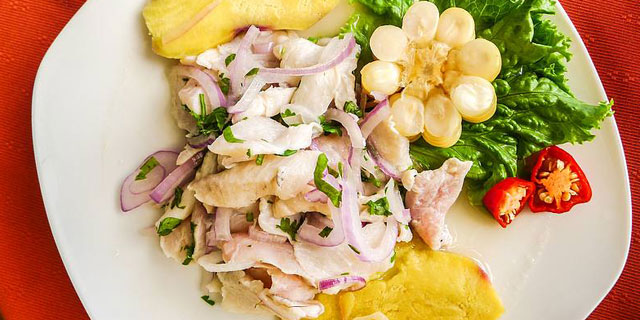The first time I ordered a ceviche in Ecuador I got what looked like shrimp soup. I figured that my rudimentary Spanish was the cause of the misunderstanding. But when it happened again later that week, I concluded there was another issue at play, and I set out to unravel why I got something so different from what I thought I had ordered.
It turns out that Ecuadorian ceviche is not the same thing as Peruvian ceviche, the one I was familiar with. Though their ingredients, seafood and lime, are the same, and their popularity in each country unparalleled – ceviche is Ecuador’s national dish and it has its own National Day (June 28) in Peru – the preparation of said ingredients results in two distinct dishes.
It is generally agreed that ceviche originated in Peru and then evolved into many national and local varieties in the Americas. There are, however, competing theories about that evolution. Archeological findings suggest that in the Pre-Spanish era the fish was marinated with banana passion fruit and later with chicha. Lime and onions were introduced by the Spaniards, from which the dish evolved into its current form.
Ceviche is considered a healthy dish that, not surprisingly, is sold in the morning hours and served only for lunch, when the fish is still fresh. A tip to make sure you eat at a reliable cevicheria, which minimizes the risk of getting sick: go to a place where you see locals and kids eating. If it’s good for them, it’s probably good for you, too.
The Peruvian Ceviche
In Peru you’ll find chunks of raw fish, shellfish, or shrimp that are ‘cooked’ in lime juice with salt, hot peppers, and sliced onions. The type of hot pepper (e.g. ají amarillo or rocotto) depends on the region, just like the type of fish (e.g. corvina, sea bass or sole). My favorite is the ceviche from Trujillo, where it’s made with incredibly tender tollo (shark).
Ceviche is served in a salad style on lettuce leaves and comes with side dishes of sweet potato, corn nuts, boiled white corn (choclo), thinly sliced onion, sometimes a bit of seaweed, and a slice of pepper (which may easily be mistaken for a piece of tomato). You can order ceviche as an appetizer or as a main meal for lunch; the ingredients are the same, only the quantity is different.
The juice in which the fish is marinated is kept separate and sold, often by street vendors, as leche de tigre (tiger milk). They serve it in a cup and add chopped tomato, onion, chili pepper, and cilantro. It’s said to cure hangovers but that’s not required to appreciate this refreshing and tangy drink.
The Ecuadorian Ceviche
In Ecuador you can often choose from a fish, shrimp, black clam, or mixto (mixture) ceviche. Unlike Peruvian ceviche, the seafood in Ecuador’s ceviche is cooked before it is marinated with lime juice and salt, and is often served in a bowl with the soupey liquid made of tomato sauce or even orange juice. It is not as spicy as the Peruvian version.
Ceviche is also a popular snack sold by vendors downtown or on the beach. It comes in a plastic cup with sliced tomato, onion, cilantro, toasted corn kernels, and chifles (sliced plantain chips). When you order it as a dish for lunch – for yourself or to share with others – the bowl with ceviche also comes with tomato, onion, and cilantro with sides of patacones, fried green plantain chunks.


![Making Mealtime Matter with La Familia: Easy Sofrito [Video]](https://thelatinkitchen.com/wp-content/uploads/2015/10/sofrito-shutterstock__0-500x383.jpg)
![Easy Latin Smoothies: Goji Berry Smoothie [Video]](https://thelatinkitchen.com/wp-content/uploads/2015/12/goji_berry-shutterstock_-500x383.jpg)
















![Fun and Fast Recipes: Fiesta Cabbage Salad [Video]](https://thelatinkitchen.com/wp-content/uploads/2015/11/fiesta_cabbage_slaw-shutterstock_-500x383.jpg)









